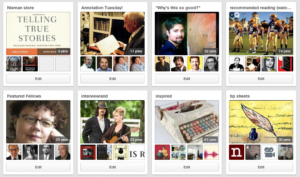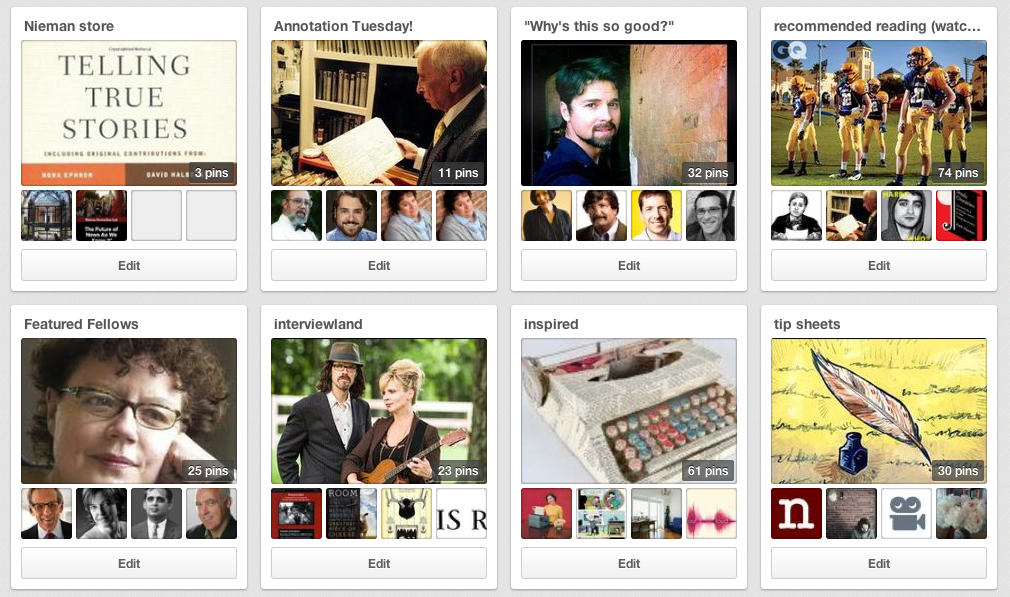Pinned for your storytelling pleasure, a roundup of recent great reads, vids, tips, etc.:
In case you missed it, Part 1: Gay Talese and Elon Green annihilated Storyboard traffic records this week with their critically acclaimed annotation of “Frank Sinatra Has a Cold,” the latest installment of our Annotation Tuesday! series. And in the archive: annotations with writers including Mary Roach, Amy Wallace, Jon Franklin, Ben Ehrenreich, Pamela Colloff and Eli Saslow, with more to come.
 ICYMI, Part 2: We went live last week with Storyboard 75: The Big Book of Narrative, a compendium of storytelling tips, essays, reading recommendations and more, from legends, innovators and masters of the craft. Revisit the difference between a news feature and a true narrative. Learn how to write scenes, to develop story characters, to self-edit, to incorporate sound into your storytelling. Or, just grab some inspiration. Here’s Pulitzer winner Richard Rhodes (No. 82): “If you learn to write, learn to write well, learn to make people and events come alive in words whether fictionally or veritably. You will always have work, and it will be the best kind of work, work that uses, work that demands everything you’ve got. Who could ask for more?”
ICYMI, Part 2: We went live last week with Storyboard 75: The Big Book of Narrative, a compendium of storytelling tips, essays, reading recommendations and more, from legends, innovators and masters of the craft. Revisit the difference between a news feature and a true narrative. Learn how to write scenes, to develop story characters, to self-edit, to incorporate sound into your storytelling. Or, just grab some inspiration. Here’s Pulitzer winner Richard Rhodes (No. 82): “If you learn to write, learn to write well, learn to make people and events come alive in words whether fictionally or veritably. You will always have work, and it will be the best kind of work, work that uses, work that demands everything you’ve got. Who could ask for more?”
Recommended reading, watching, listening, etc.:
—Twitter's Andrew Fitzgerald, who works on new ways for Twitter and journalists to collaborate, talks radio roots and evolving forms of storytelling, for TED.com.
—Jeanne Marie Laskas goes deep for GQ at the Pee Wee Super Bowl, with a piece that furthers her contributions to the national inquiry into football and brain injury.
—Rachel Kaadzi Ghansah goes searching for Dave Chappelle, for The Believer.
—Mary Pilon and the New York Times multimedia narrative team tell the story of a cage fighter, with audio narration by the Boardwalk Empire actor Bobby Cannavale.
—Susan Dominus watches Daniel Radcliffe try to make Harry Potter disappear, for the New York Times magazine.
—Wells Tower tracks that weird Elvis-ricin-Mensa-body-parts story out of Tupelo, Miss., for GQ.
—Brooke Borel does a slightly different take on bodies donated to science, for Aeon magazine.
—Jeff Sharlet profiles Harry Belafonte for VQR.
—Bill Wasik, editor of the Harper’s anthology Submersion Journalism, talks first-person depth and undercover reporting with Ted Conover, Brooke Kroeger, Jeff Sharlet and others at NYU. (video, 2008)
—Chris Jones ticktocks the flight out of Dallas in the hours after John F. Kennedy's assassination, for Esquire.
Tip sheets:
—“I wish I hadn’t thought I had to be so smart,” Tampa Bay Times reporter Lane DeGregory writes in “Letter to a Young Journalist.”
—“Watching is one of the most under-used tools in reporting. It involves silence,” says the Washington Post’s Anne Hull, in tips culled from an appearance at the former Nieman Narrative Journalism Conference.
—“Stop being boring,” writes Buzzfeed in the one useful item on its “Most Honest ‘10 Rules for Writers’” list. (Okay, the one about exclamation points is pretty good, too.)
—“The most important (thing) is to be locked down in the process,” the longtime columnist and novelist Carl Hiaasen says, on developing strong work habits, in Fast Company’s “5 Creative Tips from Carl Hiaasen, Florida’s Cleverest Chronicler.”
For past installments from the Pinned series go here.
In case you missed it, Part 1: Gay Talese and Elon Green annihilated Storyboard traffic records this week with their critically acclaimed annotation of “Frank Sinatra Has a Cold,” the latest installment of our Annotation Tuesday! series. And in the archive: annotations with writers including Mary Roach, Amy Wallace, Jon Franklin, Ben Ehrenreich, Pamela Colloff and Eli Saslow, with more to come.
 ICYMI, Part 2: We went live last week with Storyboard 75: The Big Book of Narrative, a compendium of storytelling tips, essays, reading recommendations and more, from legends, innovators and masters of the craft. Revisit the difference between a news feature and a true narrative. Learn how to write scenes, to develop story characters, to self-edit, to incorporate sound into your storytelling. Or, just grab some inspiration. Here’s Pulitzer winner Richard Rhodes (No. 82): “If you learn to write, learn to write well, learn to make people and events come alive in words whether fictionally or veritably. You will always have work, and it will be the best kind of work, work that uses, work that demands everything you’ve got. Who could ask for more?”
ICYMI, Part 2: We went live last week with Storyboard 75: The Big Book of Narrative, a compendium of storytelling tips, essays, reading recommendations and more, from legends, innovators and masters of the craft. Revisit the difference between a news feature and a true narrative. Learn how to write scenes, to develop story characters, to self-edit, to incorporate sound into your storytelling. Or, just grab some inspiration. Here’s Pulitzer winner Richard Rhodes (No. 82): “If you learn to write, learn to write well, learn to make people and events come alive in words whether fictionally or veritably. You will always have work, and it will be the best kind of work, work that uses, work that demands everything you’ve got. Who could ask for more?”Recommended reading, watching, listening, etc.:
—Twitter's Andrew Fitzgerald, who works on new ways for Twitter and journalists to collaborate, talks radio roots and evolving forms of storytelling, for TED.com.
—Jeanne Marie Laskas goes deep for GQ at the Pee Wee Super Bowl, with a piece that furthers her contributions to the national inquiry into football and brain injury.
—Rachel Kaadzi Ghansah goes searching for Dave Chappelle, for The Believer.
—Mary Pilon and the New York Times multimedia narrative team tell the story of a cage fighter, with audio narration by the Boardwalk Empire actor Bobby Cannavale.
—Susan Dominus watches Daniel Radcliffe try to make Harry Potter disappear, for the New York Times magazine.
—Wells Tower tracks that weird Elvis-ricin-Mensa-body-parts story out of Tupelo, Miss., for GQ.
—Brooke Borel does a slightly different take on bodies donated to science, for Aeon magazine.
—Jeff Sharlet profiles Harry Belafonte for VQR.
—Bill Wasik, editor of the Harper’s anthology Submersion Journalism, talks first-person depth and undercover reporting with Ted Conover, Brooke Kroeger, Jeff Sharlet and others at NYU. (video, 2008)
—Chris Jones ticktocks the flight out of Dallas in the hours after John F. Kennedy's assassination, for Esquire.
Tip sheets:
—“I wish I hadn’t thought I had to be so smart,” Tampa Bay Times reporter Lane DeGregory writes in “Letter to a Young Journalist.”
—“Watching is one of the most under-used tools in reporting. It involves silence,” says the Washington Post’s Anne Hull, in tips culled from an appearance at the former Nieman Narrative Journalism Conference.
—“Stop being boring,” writes Buzzfeed in the one useful item on its “Most Honest ‘10 Rules for Writers’” list. (Okay, the one about exclamation points is pretty good, too.)
—“The most important (thing) is to be locked down in the process,” the longtime columnist and novelist Carl Hiaasen says, on developing strong work habits, in Fast Company’s “5 Creative Tips from Carl Hiaasen, Florida’s Cleverest Chronicler.”
For past installments from the Pinned series go here.



